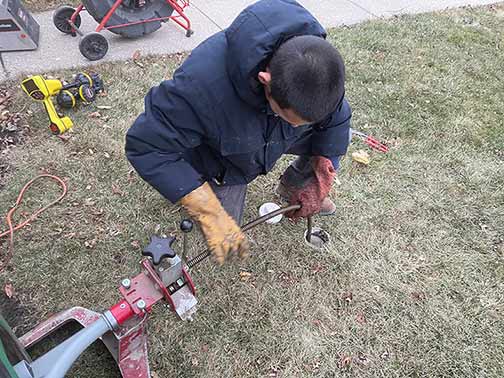
When planning to have your drainpipes and sewer line cleaned, the two top-rated professional drain-cleaning methods you want to consider are hydro-jetting and sewer rodding, says Dallas Property Management. This is true whether you are simply trying to remove blockages or doing routine plumbing maintenance.
Sewer rodding and hydro-jetting are the two most used professional drain-cleaning methods for a reason. They are effective in both commercial and residential plumbing systems. They can be used for pipes of all sizes, regardless of their location in your drainage system.
However, since the two methods are different, they still have their pros and cons. If you had to choose between hydro-jetting and sewer rodding, which one should you choose? To answer this question, it is essential to first explain these two drain-cleaning methods.
What is sewer rodding?
This process involves inserting a flexible rod into a clogged drainpipe or sewer line and using the rod to break up the debris inside the channel. Sometimes, the rod has a grappling hook as an attachment to snag and retrieve the materials clogging the drainage system.
To enable it to access the deepest recesses of a blocked sewer line or drainpipe, the length of the flexible rod used in this operation can be increased. This is possible because each rod comes with a screw at one end, allowing them to be joined end-to-end to make the line longer.
Power rodding is a type of sewer rodding. It uses a rotating metal cable instead of stackable flexible rods. Power rodding is more effective than standard sewer rodding. Sewer rodding can be used to remove sludge, paper products, grease, tree roots, and all kinds of difficult blockages.
What is hydro-jetting?
Hydro-jetting uses water as its primary means of getting rid of debris inside a clogged drainage pipe or sewer line. To clear the clogged line, a flexible hose with a stainless steel nozzle attached to one end is inserted into the drain and connected to a jetter.
To clean the pipe, the jetter shoots pressurized water into the offending pipe via the nozzle. Due to its high pressure – up to 3,500 pounds per square inch (psi) – this water can blast away the debris inside the line and also scour the walls of the pipe at the same time.
Different types of nozzles are used for different types of clogs. The water pressure can also be adjusted to match the type of pipe, its condition, and the nature of the blockage inside it. Hydro-jetting will remove tree roots, sludge, paper products, grease, and other buildup.

Should you use hydro-jetting or sewer rodding?
Sewer rodding and hydro-jetting are excellent drain-cleaning methods, but each has unique strengths and weaknesses. Here are the things you should consider when choosing between hydro-jetting and sewer rodding.
- The type of clogs and blockages
Hydro-jetting and sewer rodding don’t handle clogs in the same way. Hydro-jetting is the recommended method if you are dealing with recurring clogs and severe buildup caused by things like mineral buildup, grease, ice, or hardened buildup.
- The outcome of the operation
Sewer rodding will leave debris inside your pipe. Although it can break up or dislodge the blockage inside the pipe, it will not clear them out of the line. Hydro-jetting, on the other hand, will wash the debris out of the line and wash your pipe walls. This is why hydro-jetting is better for recurring clogs.
- The condition of the pipe
Hydro-jetting places more stress on your pipes. Although the water pressure used in hydro-jetting can be altered to protect the pipes, this method can still harm old and weakened pipes. Sewer rodding is gentler and more suitable for older pipes.
- The cost
Sewer rodding is generally more affordable than hydro-jetting. That is why sewer rodding is often the go-to drain-cleaning method for residential plumbing systems. Hydro-jetting is reserved as a second option if sewer rodding fails to deliver the desired results.
- Type of plumbing system
For commercial plumbing systems, which are tougher and subject to heavy usage, hydro-jetting is the better method. Because of how quickly drain problems can escalate in commercial buildings, hydro-jetting is usually preferred.
Which method should you choose?
There is no one-size-fits-all answer to this question. The proper drain-cleaning method for your plumbing depends on careful consideration of the listed factors. Before choosing a drain-cleaning method, it is a good idea to have a professional plumber inspect your drainage pipes.
An experienced plumber can evaluate the condition of your drainage system by performing a sewer camera inspection. This critical step will reveal the underlying issues in the sewer line or drainpipe that can help you decide the right drain-cleaning method for your plumbing.
The plumber you hire when cleaning your drains is even more essential than the drain-cleaning method you choose. An experienced plumber will take additional care to ensure not only proper drain cleaning but also the safety and longevity of your drainage system.